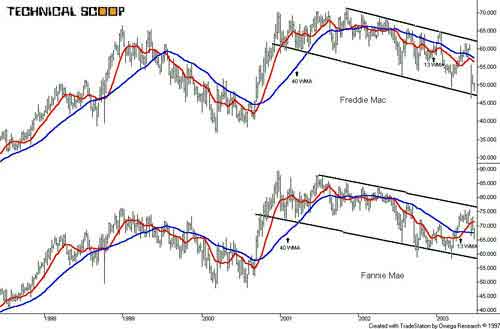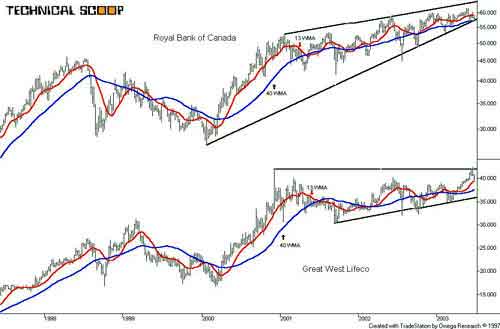|
|||
Looming mortgage crisis!David Chapman Freddie and Fannie have suddenly found themselves at the center of a quietly growing storm. Freddie of course is the Federal Home Loan Mortgage Corporation (FRE-NYSE) and Fannie is the Federal National Mortgage Association (FNM-NYSE). Together the two twins are the heart of the US mortgage system. How they work is that the banks make the mortgages which are usually for 30 year terms but since banks do not attract 30 year deposits they sell the mortgages to Freddie and Fannie who in turn finance them with issuances of long bonds. Or Freddie and Fannie might re-bundle the mortgages and re-sell them as mortgage backed securities. So what's the hitch? Well in the US the mortgage borrowers can redeem their mortgages without any substantial penalties. With interest rates falling over the past few years homeowners have refinanced their homes in record numbers and more often than not taking out more as they tap into the growing equity in their homes due to sharply rising prices. Since 2001 it is estimated that homeowners have withdrawn $450 billion in equity from their properties. This huge withdrawal has gone a long way to finance the boom in retail sales over the past few years. But Freddie and Fannie can't change the terms on their bonds so easily. The result is what was a profitable business with the long mortgages locked in with bonds at lower rates it is now a multi billion dollar book of long mortgages at lower rates with the bonds still at the old higher rates. They have of course been managing the resulting interest rate risk with derivatives (Freddie and Fannie are the largest users of interest rate swaps in the world) but herein lies the problem. Accounting for derivatives is not easy and now stories of irregularities have surfaced. It has already cost the COO, CFO, CEO and Chairman of Freddie Mac their jobs whether through outright release or the more gentle "retired." Criminal investigations are underway. If Freddie and Fannie could potentially blow up because of derivatives irregularities then there is the potential for others to blow up. We are reminded that while Freddie and Fannie may be huge users of derivatives J.P. Morgan Chase & Co. (JPM-TSX) is the world's largest holder of derivatives with an estimated book of $24 trillion (yes trillion) in a market estimated to be in excess of $100 trillion. And General Electric (GE-NYSE) is the world's largest corporate user of derivatives (no it is not a refrigerator company). For JPM it dwarfs their actual hard assets and the risk to capital of a book that size is in theory larger than their capital. But Freddie and Fannie would be in the category of too big to fail. If there is a blowup, ultimately someone pays. Recall the Savings and Loan debacle of the late 1980's that contributed to the recession of the early nineties and led to numerous collapses, criminal charges, empty offices and falling real estate prices. We suspect that the debacle at Freddie and Fannie will lead to a comparable shakeout in the real estate industry.
So with the potential for a serious waning in housing prices supported by recent surveys that show that house and car sales, two key economic drivers are slowing, the potential for a bigger problem is looming if house prices actually began to fall. Recent statistics showed that foreclosure rates hit a record 1.2% in the first quarter while the delinquency rate remained stable at 4.5%. Clearly if the economy slips further despite the liquidity efforts of the Federal Reserve these numbers could deteriorate further. With the investigations into Freddie Mac and now Fannie Mae some have dared to say that they could become a crisis comparable to the Long Term Capital Management collapse of 1998. This would be far worse. But clearly Freddie and Fannie along with Easy Al have gone a long way in generating the biggest housing bubble in history. An implosion here would not only completely shatter the US housing market but it would have far reaching ramifications on the world's financial system. Clearly there are those who do not agree with this potential scenario but if there is smoke there is usually fire and it may not be easily contained if other financial problems arose or the proverbial financial accident happened. The situation in Canada is not that much different although Canadians do not have a Freddie or Fannie and unlike the US there are penalties for early redemption of a mortgage. Still Canadians have borrowed an extra $12 billion by refinancing mortgages and a further $10 billion in expanded lines of credit according to a CIBC World Markets report. And as in the US the money has largely gone into supporting consumer spending. This is a game that can clearly only survive if the housing market maintains firmness in prices. Signs are beginning to show, however, that the top may be behind us as sales are beginning to fall. Financial stocks are key to the health of the major indices. If the financial stocks are in trouble the indices are in trouble and so to is the economy. Since the lows seen in October 2002 and again in March 2003 the financial stocks have led the market up. The troubles that have surfaced with both Freddie and Fannie have seen their stocks take respective drops from highs of 11% and 14% to June 25. But the charts of Freddie and Fannie do not generate a lot of confidence, as they are both clearly in a massive multi-year rollover patterns. Both have fallen under their respective 40-week moving averages. These massive rollover patterns always end poorly so investors would be wise to heed them. And usually it means that they eventually break down out of the more gently sloping down pattern for an inevitable crash.
And investors who are in Canadian financial stocks need not be complacent that this is just an American problem and is isolated at these two giants. An implosion at these two giants means trouble for all financial companies. Our second chart shows both the Royal Bank of Canada (RY-TSX, NYSE) (www.royalbank.com, 416-974-8393), Canada's largest financial institution and Great West Lifeco Inc. (GWO-TSX) (www.gwl.ca, 204-946-4129) one of Canada's largest insurance companies. Both of these giants are of course major lenders in the mortgage market and Royal Bank is one of Canada's leading derivative banks. The weekly chart of the Royal Bank shows one that has performed quite well since 2000 and has been a major leader for the TSX. But it is forming a multi-year rising wedge formation, which is bearish when it breaks to the downside. The breakdown point currently lies just above $57. The projection for the rising wedge formation is a drop to roughly $30. Great West Lifeco has been forming what appears to be a multi-year double top on the charts. This is a considerable period of distribution but suggests a drop to at least the low $20's once we break the neckline near $35.
There is a complacency out there that seems to believe that by pumping the market with liquidity and lowering interest rates will shake the economy loose and start us back on the road to recovery. But debt-wise the consumer and the corporations are tapped out. So all the liquidity priming and interest rate cutting in the world will do little to actually get things moving again. We have long been in the camp that we will have a major debt shakeout. The looming mortgage crisis, possibly triggered by the collapse of Freddie and Fannie, are part of the iceberg. But more is becoming visible and we continue to try and go full throttle ahead not heeding the warning signs. David Chapman Note: Charts created using
Omega TradeStation or SuperCharts. Chart data supplied by Dial
Data. |

 Already there
are signs that the real estate market is topping out as sales
fall and consumer confidence wanes. Much of the huge draw down
of mortgage funds over the past few years has gone to support
retail sales and some may have gone to pay down personal debt
but the majority has gone straight into consumer spending. Of
course all of this has been coming in the face of anemic personal
income growth and personal consumption expenditures growth that
has routinely been ahead of personal income growth. As one pundit
noted the consumers have "turned their homes into ATMs."
Already there
are signs that the real estate market is topping out as sales
fall and consumer confidence wanes. Much of the huge draw down
of mortgage funds over the past few years has gone to support
retail sales and some may have gone to pay down personal debt
but the majority has gone straight into consumer spending. Of
course all of this has been coming in the face of anemic personal
income growth and personal consumption expenditures growth that
has routinely been ahead of personal income growth. As one pundit
noted the consumers have "turned their homes into ATMs."
